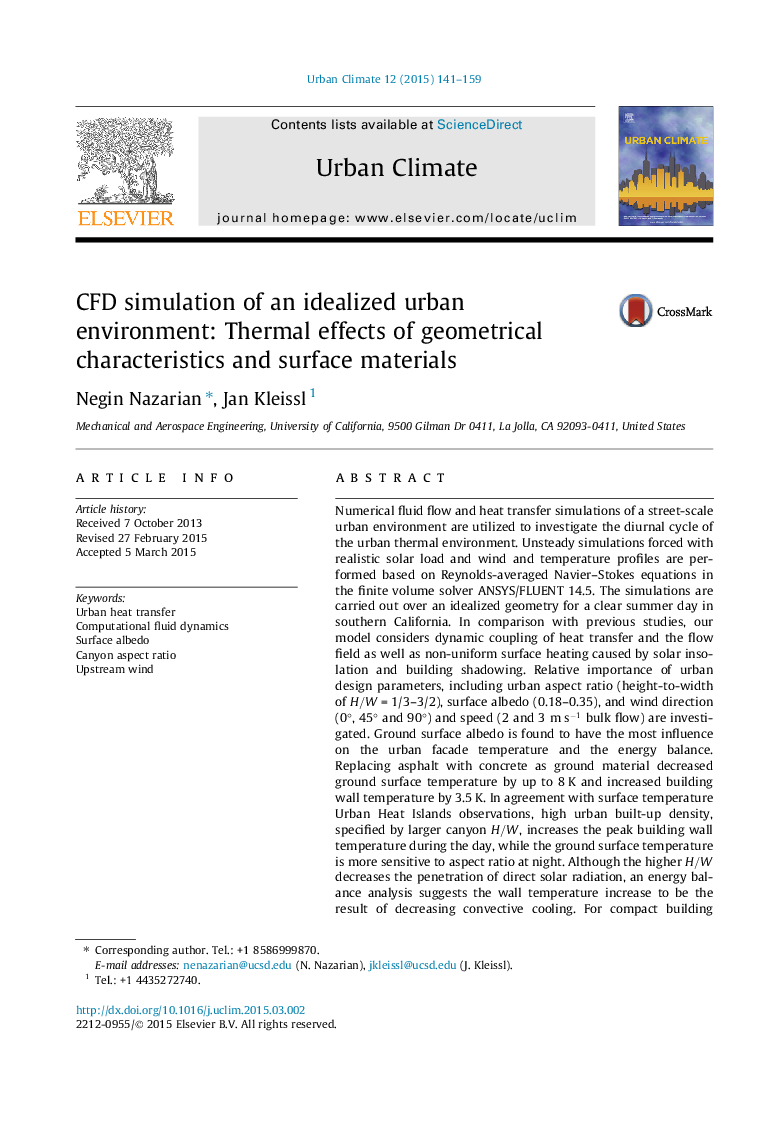| کد مقاله | کد نشریه | سال انتشار | مقاله انگلیسی | نسخه تمام متن |
|---|---|---|---|---|
| 143716 | 163465 | 2015 | 19 صفحه PDF | دانلود رایگان |
• Comprehensive unsteady simulations of street-scale urban environment are performed.
• Thermal field in response to geometrical and surface characteristics is examined.
• Ground surface albedo is found to have the most influence on the temperature and energy balance components.
• Urban built-up density outweighs the effects of wind speed and direction on the ground temperature.
• The ground surface temperature is more sensitive to canyon aspect ratio at night.
Numerical fluid flow and heat transfer simulations of a street-scale urban environment are utilized to investigate the diurnal cycle of the urban thermal environment. Unsteady simulations forced with realistic solar load and wind and temperature profiles are performed based on Reynolds-averaged Navier–Stokes equations in the finite volume solver ANSYS/FLUENT 14.5. The simulations are carried out over an idealized geometry for a clear summer day in southern California. In comparison with previous studies, our model considers dynamic coupling of heat transfer and the flow field as well as non-uniform surface heating caused by solar insolation and building shadowing. Relative importance of urban design parameters, including urban aspect ratio (height-to-width of H/WH/W = 1/3–3/2), surface albedo (0.18–0.35), and wind direction (0°, 45° and 90°) and speed (2 and 3 ms-1 bulk flow) are investigated. Ground surface albedo is found to have the most influence on the urban facade temperature and the energy balance. Replacing asphalt with concrete as ground material decreased ground surface temperature by up to 8 K and increased building wall temperature by 3.5 K. In agreement with surface temperature Urban Heat Islands observations, high urban built-up density, specified by larger canyon H/WH/W, increases the peak building wall temperature during the day, while the ground surface temperature is more sensitive to aspect ratio at night. Although the higher H/WH/W decreases the penetration of direct solar radiation, an energy balance analysis suggests the wall temperature increase to be the result of decreasing convective cooling. For compact building configuration (canyon H/WH/W of 1), rotating the wind direction 45° away from the canyon axis and increasing average bulk velocity at the inlet did not significantly influence the wind speed inside the canyon and therefore ground temperatures, while peak roof temperature is strongly influenced. Therefore urban built-up density outweighs the effects of wind speed and direction on the ground temperature.
Journal: Urban Climate - Volume 12, June 2015, Pages 141–159
